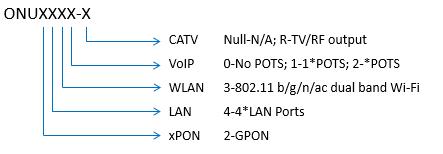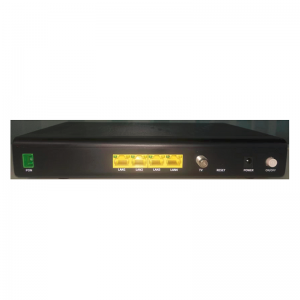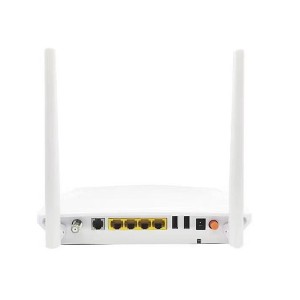ONU2430
Short Description:
Product Detail
Product Tags

Product Overview
The ONU2430 Series is a GPON-technology-based gateway ONU designed for home and SOHO (small office and home office) users. It is designed with one optical interface which is compliant with ITU-T G.984.1 Standards. The fiber access provides high-speed data channels and meets FTTH requirements, which can provide enough bandwidth Supports for a variety of emerging network services.
Options with one/two POTS voice interfaces, 4 channels of 10/100/1000M Ethernet interface are provided, which allow simultaneous use by multiple users. Moreover, it provides 802.11b/g/n/ac dual bands Wi-Fi interface. It supports flexible applications and plug and play, as well as provides high-quality voice, data, and high-definition video services to users.
Note that picture of the product differs for different models of the ONU2430 Series. Refer to ordering Information section for details on the options.
Features
Use point to multipoint network topology, providing 4 Giga Ethernet interfaces and dual band Wi-Fi
Provide OLT remote management; support local console management; support user-side Ethernet
interface line loopback detection
Support DHCP Option60 to report physical location information of the Ethernet interface
Support PPPoE + for accurate identification of users
Support IGMP v2, v3, Snooping
Supports broadcast storm suppression
Support 802.11b/g/n/ac (Dual Band Wi-Fi)
Compatible with OLT from Huawei, ZTE etc
RF (TV) port enable/disable remotely
Technical Parameters
| Product Overview | |
| WAN | PON port with SC/APC Optical Module Connector |
| LAN | 4xGb Ethernet RJ45 |
| POTS | 2xPOTS ports RJ11 (Optional) |
| RF | 1 port CATV (Optional) |
| Wireless Wi-Fi | WLAN 802.11 b/g/n/ac |
| USB | 1 port USB 2.0 (Optional) |
| Port/Button | |
| ON/OFF | Power button, used to power on or power off the device. |
| POWER | Power port, used to connect the power adapter. |
| USB | USB Host port, used to connect to USB storage devices. |
| TEL1-TEL2 | VOIP telephone ports (RJ11), used to connect to the ports on telephone sets. |
| LAN1-LAN4 | Auto-sensing 10/100/1000M Base-T Ethernet ports (RJ45), used to connect to PC or IP (Set-Top-Box) STBs. |
| CATV | RF port, used to connect to a TV set. |
| Reset | Reset button, Press the button for a short time to reset the device; press the button for a long time (Longer than 10s) to restore the device to the default settings and reset the device. |
| WLAN | WLAN button, used to enable or disable the WLAN function. |
| WPS | Indicates the WLAN protected setup. |
| GPON Uplink | |
| The GPON system is a single-fiber bidirectional system. It uses wavelengths 1310 nm in TDMA mode in the upstream direction and wavelengths 1490 nm in broadcast mode in the downstream direction. | |
| The maximum downstream rate at the GPON physical layer is 2.488 Gbit/s. | |
| The maximum upstream rate at the GPON physical layer is 1.244 Gbit/s. | |
| Supports a maximum logical distance of 60 km and a physical distance of 20 km between the
remotest ONT and nearest ONT, which are defined in ITU-T G.984.1. |
|
| Supports a maximum of eight T-CONTs. Supports T-CONT types Type1 to Type5. One T-CONT supports multiple GEM ports (maximum of 32 GEM ports are supported). | |
| Supports three authentication modes: by SN, by password, and by SN + password. | |
| Upstream throughput: the throughput is 1G for 64-byte packets or other types of packets in RC4.0 version. | |
| Downstream throughput: The throughput of any packets is 1 Gbit/s. | |
| If the traffic does not exceed 90% of the system throughput, the transmission delay in the upstream direction (from UNI to SNI) is less than 1.5 ms (for Ethernet packets of 64 to 1518 bytes), and that in the downstream direction (from SNI to UNI) is less than 1 ms (for Ethernet packets of any length). | |
| LAN | |
| 4xGb Ethernet | Four auto-sensing 10/100/1000 Base-T Ethernet ports (RJ-45): LAN1-LAN4 |
| Ethernet Features | Auto-negotiation of rate and duplex mode
MDI/MDI-X auto-sensing Ethernet frame of up to 2000 bytes Up to 1024 local switch MAC entries MAC forwarding |
| Route Features | Static route,
NAT, NAPT, and extended ALG DHCP server/client PPPoE client |
| Configuration | The LAN1 and LAN2 ports are mapped to the Internet WAN Connection. |
| The LAN3 and LAN4 ports are mapped to the IPTV WAN Connection. | |
| VLAN #1 mapped to LAN1, LAN2 and Wi-Fi are in Routed for Internet with default IP 192.168.1.1 and DHCP class 192.168.1.0/24 | |
| VLAN #2 mapped to LAN2 and LAN4 are in Bridged for IPTV | |
| Multicast | |
| IGMP Version | v1,v2,v3 |
| IGMP Snooping | Yes |
| IGMP Proxy | No |
| Multicast groups | Up to 255 multicast groups at the same time |
| POTS | |
| One/Two VoIP telephone ports (RJ11): TEL1, TEL2 | G.711A/u, G.729 and T.38
Real-time Transport Protocol (RTP)/RTP Control Protocol (RTCP) (RFC 3550) Session Initiation Protocol (SIP) Dual-tone multi-frequency (DTMF) detection Frequency shift keying (FSK) sending Two phone users to call at the same time |
| Wireless LAN | |
| WLAN | IEEE 802.11b/802.11g/802.11n/802.11ac |
| Wi-Fi Bands | 5GHz (20/40/80 MHz) and 2.4GHz (20/40 MHz) |
| Authentication | Wi-Fi protected access (WPA) and WPA2 |
| SSIDs | Multiple service set identifiers (SSIDs) |
| Enable by Default | Yes |
| RF Port | |
| Operating Wavelength | 1200~1600 nm, 1550 nm |
| Input Optical Power | -10~0 dBm (Analog); -15 ~ 0 dBm (Digital) |
| Frequency Range | 47-1006 MHz |
| In-band Flatness | +/-1dB@47-1006 MHz |
| RF Output Reflection | >=16dB @ 47-550 MHz; >=14dB@550-1006 MHz |
| RF Output Level | >=80dBuV |
| RF Output Impedance | 75 ohms |
| Carrier-to-Noise Ratio | >=51dB |
| CTB | >=65dB |
| SCO | >=62dB |
| USB | |
| Complying the USB 2.0 | |
| Physical | |
| Dimension | 250*175*45 mm |
| Weight | 700g |
| Power Supply | |
| Power Adapter output | 12V/2A |
| Static Power consumption | 9W |
| Average Power consumption | 11W |
| Maximum Power consumption | 19W |
| Ambient | |
| Operation Temperature | 0~45°C |
| Storage Temperature | -10 ~ 60°C |
Ordering Information
ONU2430 Series:

Ex: ONU2431-R, that is, GPON ONU with 4*LAN + Dual Band WLAN + 1*POTS + CATV output.





